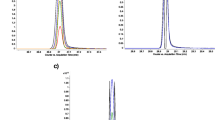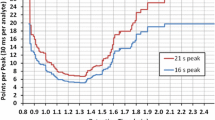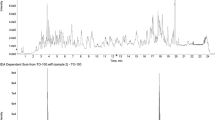Abstract
This paper presented the applications of liquid chromatography electrospray ionization tandem mass spectrometry (LC/ESI-MS/MS) and ultra-high-pressure liquid chromatography electrospray ionization quadrupole time-of-flight mass spectrometry (UHPLC QqTOF MS) for the determination of 148 pesticides in fruits and vegetables. Pesticides were extracted from fruits and vegetables using a buffered QuEChERS method. Quantification was achieved using matrix-matched standard calibration curves with isotopically labeled standards or a chemical analog as internal standards in an analytical range from 5 to 500 μg/kg. The method performance parameters including overall recovery, intermediate precision, and measurement uncertainty were evaluated according to a statistically designed experiment, i.e., a nested design. For LC/ESI-MS/MS, 95% of the pesticides had recoveries between 81% and 110%; 97% had an intermediate precision ≤20%; and 95% (in fruits) or 93% (in vegetables) showed measurement uncertainty ≤40%. Compared to LC/ESI-MS/MS, UHPLC QqTOF MS showed a relatively poor repeatability and large measurement uncertainty. About 93% (in fruits) or 94% (in vegetables) of the pesticides had recoveries between 81% and 110%; 86% (in fruits) or 90% (in vegetables) had an intermediate precision ≤20%; and 79% (in fruits) or 88% (in vegetables) showed measurement uncertainty ≤40%. LC/ESI-MS/MS proved to be the first choice for quantification or pre-target analysis due to its superior sensitivity and good repeatability. UHPLC QqTOF MS provided accurate mass measurement and isotopic patterns, and was an ideal tool for post-target screening and confirmation.




Similar content being viewed by others
References
Pico Y, Blasco C, Font G (2004) Environmental and food applications of LC-tandem mass spectrometry in pesticide-residue analysis: an overview. Mass Spectrom Rev 23:45–85
Alder L, Greulich K, Kempe G, Vieth B (2006) Residue analysis of 500 high priority pesticides: better by GC-MS or LC-MS/MS? Mass Spectrom Rev 25:838–865
Pico Y, Font G, Ruiz MJ, Fernandez M (2006) Control of pesticide residues by liquid chromatography-mass spectrometry to ensure food safety. Mass Spectrom Rev 25:917–960
Lacorte S, Fernandez-Alba AR (2006) Time of flight mass spectrometry applied to the liquid chromatographic analysis of pesticides in water and food. Mass Spectrom Rev 25:866–880
Soler C, Manes J, Pico Y (2008) The role of the liquid chromatography-mass spectrometry in pesticide residue determination in food. Crit Rev Anal Chem 38:93–117
Wang J, Leung D, Butterworth F (2005) Determination of five macrolide antibiotic residues in eggs using liquid chromatography/electrospray ionization tandem mass spectrometry. J Agric Food Chem 53:1857–1865
Wang J, Wotherspoon D (2007) Determination of pesticides in apples by liquid chromatography with electrospray ionization tandem mass spectrometry and estimation of measurement uncertainty. J AOAC Int 90:550–567
Wang J, Leung D (2009) Applications of ultra-performance liquid chromatography electrospray ionization quadrupole time-of-flight mass spectrometry on analysis of 138 pesticides in fruit- and vegetable-based infant foods. J Agric Food Chem 57:2162–2173
Lehotay SJ (2007) Determination of pesticide residues in foods by acetonitrile extraction and partitioning with magnesium sulfate: collaborative study. J AOAC Int 90:485–520
Lehotay SJ, Mastovska K, Lightfield AR (2005) Use of buffering and other means to improve results of problematic pesticides in a fast and easy method for residue analysis of fruits and vegetables. J AOAC Int 88:615–629
AOAC Official Method 2007.01 (2007) Official methods of analysis. AOAC, Gaithersburg, MD
Document No SANCO/2007/3131 (2007) http://ec.europa.eu/food/plant/protection/resources/qualcontrol_en.pdf. (Aug-21-2009)
Acknowledgment
Authors are grateful to Fred Butterworth, Calgary Laboratory, Canadian Food Inspection Agency, for comments on this paper.
Author information
Authors and Affiliations
Corresponding author
Rights and permissions
About this article
Cite this article
Wang, J., Chow, W. & Leung, D. Applications of LC/ESI-MS/MS and UHPLC QqTOF MS for the determination of 148 pesticides in fruits and vegetables. Anal Bioanal Chem 396, 1513–1538 (2010). https://doi.org/10.1007/s00216-009-3331-6
Received:
Revised:
Accepted:
Published:
Issue Date:
DOI: https://doi.org/10.1007/s00216-009-3331-6




